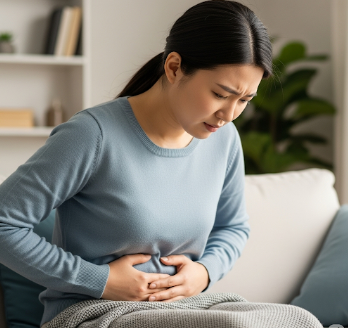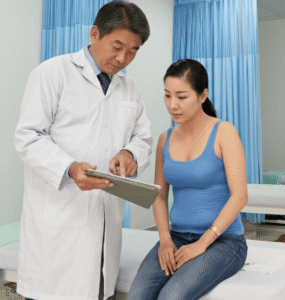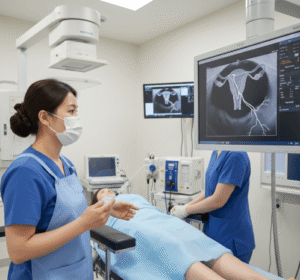Overview
Ovary pain, also known as ovarian pain or ovarian discomfort, refers to pain or discomfort in the lower abdomen or pelvic region associated with the ovaries. It can be sharp, dull, or intermittent and may occur on one or both sides. Ovary pain is a common gynecological symptom experienced by women of reproductive age, and it can signal normal physiological processes like ovulation or underlying medical conditions requiring attention.
In Korea, ovary pain is managed by gynecologists and reproductive specialists, with careful evaluation to distinguish benign, physiological causes from serious conditions like ovarian cysts, endometriosis, or ovarian torsion.
Key Facts
➤ Ovary pain can be acute or chronic and vary in intensity.
➤ Commonly related to ovulation, menstrual cycles, or pregnancy.
➤ May indicate gynecological conditions such as ovarian cysts, endometriosis, or pelvic inflammatory disease.
➤ Severe or sudden pain could signal emergency conditions like ovarian torsion or rupture.
➤ In Korea, modern diagnostic imaging and minimally invasive treatments help manage ovary pain effectively.
What is Ovary Pain?
Ovary pain arises from disturbances in ovarian tissue or surrounding pelvic structures.
➔ Typical characteristics:
- Sharp, stabbing, or dull ache in the lower abdomen.
- Localized pain on one side or sometimes bilateral.
- May be cyclical, coinciding with menstrual cycles or ovulation.
- Can be accompanied by nausea, bloating, or urinary discomfort.
Associated conditions include:
- Functional ovarian cysts – fluid-filled sacs forming during ovulation.
- Endometriosis – tissue similar to the uterine lining growing outside the uterus.
- Ovarian torsion – twisting of the ovary causing acute, severe pain.
- Pelvic inflammatory disease (PID) – infection of the reproductive organs.
- Ectopic pregnancy – pregnancy outside the uterus, often in a fallopian tube.
Symptoms Related to Ovary Pain
➤ Lower abdominal or pelvic pain, sometimes radiating to the back or thighs.
➤ Pain during ovulation or menstruation (mittelschmerz).
➤ Nausea, vomiting, or bloating in some cases.
➤ Pain during sexual intercourse or physical activity.
➤ Urinary frequency or bowel changes if surrounding organs are affected.
➤ Fever or abnormal vaginal discharge if infection is present.
Causes / Possible Causes
Physiological Causes
➤ Ovulation pain (mittelschmerz) – normal ovulation-related discomfort.
➤ Menstrual cramps – uterine contractions may refer pain to ovaries.
Gynecological Conditions
➤ Ovarian cysts – can be functional or pathological.
➤ Endometriosis – ectopic endometrial tissue causes chronic pain.
➤ Ovarian torsion – surgical emergency requiring immediate attention.
➤ Pelvic inflammatory disease – bacterial infection of reproductive organs.
➤ Ectopic pregnancy – often presents with unilateral ovary pain.
Other Causes
➤ Gastrointestinal issues – such as constipation, gas, or appendicitis.
➤ Urinary tract infections (UTIs) – causing lower abdominal discomfort.
➤ Musculoskeletal pain – due to pelvic or lower back strain.
Risk Factors
➤ Women of reproductive age – more likely to experience ovulation-related pain.
➤ History of ovarian cysts or endometriosis.
➤ Pelvic infections – PID or sexually transmitted infections (STIs).
➤ Previous abdominal or pelvic surgeries – adhesions may cause pain.
➤ Pregnancy complications – including ectopic pregnancy.
Complications
Ovary pain may lead to:
➤ Severe acute pain requiring emergency care (e.g., ovarian torsion or ruptured cyst).
➤ Infertility or reproductive complications if related to endometriosis or PID.
➤ Chronic pelvic pain affecting daily life.
➤ Emotional distress or anxiety due to ongoing discomfort.
➤ Surgical interventions in severe cases to prevent organ damage.
When Should I See My Doctor?
Seek medical attention if:
➤ Pain is sudden, severe, or unilateral.
➤ Associated with fever, vomiting, or fainting.
➤ Abnormal bleeding or unusual vaginal discharge occurs.
➤ Pain persists beyond a few days or worsens over time.
➤ There is suspected pregnancy or history of ectopic pregnancy.
Care and Treatment
Lifestyle and Home Measures
➤ Heat therapy – warm compresses or heating pads on the lower abdomen.
➤ Pain relief – NSAIDs like ibuprofen, under medical guidance.
➤ Dietary adjustments – reducing bloating triggers such as high-sodium foods.
➤ Gentle exercise or stretching – to relieve muscle tension.
Medical Treatments
➤ Hormonal therapy – birth control pills to regulate cycles and reduce cyst formation.
➤ Antibiotics – for infections such as PID or UTIs.
➤ Surgery – laparoscopic removal of cysts, endometriosis lesions, or to correct torsion.
➤ Pain management – prescription analgesics for chronic or severe pain.
Preventive Measures
➤ Regular gynecological check-ups to monitor ovarian health.
➤ Early treatment of infections to prevent PID.
➤ Awareness of ovulation cycles to differentiate normal physiological pain.
➤ Prompt medical evaluation for abnormal or persistent pain.
Treatment Options in Korea
Korean hospitals provide advanced care for ovary pain, including:
Diagnostic Services
➤ Pelvic ultrasound – detects ovarian cysts, masses, or torsion.
➤ MRI or CT scans – for detailed assessment of complex cases.
➤ Blood tests – hormone levels, infection markers, and pregnancy tests.
➤ Laparoscopy – both diagnostic and therapeutic for conditions like endometriosis.
Therapies and Supportive Care
➤ Minimally invasive surgery – laparoscopic cystectomy or ovarian surgery.
➤ Hormonal treatments – cycle regulation and pain reduction.
➤ Pain management programs – including medications and physical therapy.
➤ Multidisciplinary approach – gynecologists, reproductive endocrinologists, and pain specialists.
➤ Patient education – on ovulation pain, warning signs, and preventive strategies.
✅ In summary: Ovary pain is a common symptom affecting women, caused by physiological, gynecological, or other medical conditions. In Korea, early diagnosis, minimally invasive treatments, and multidisciplinary care ensure effective management, pain relief, and prevention of complications.













